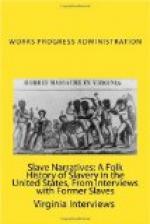One of the saddest, darkest and most pathetic conditions that existed during the period of slavery was the intimate mingling of slave owners, in fact many white men, with negro women. It has become known that very often a slave was sold who was the direct offspring of his or her owner. This practice prevailed to some extent in the Purchase Region, but was not universal. When the emancipation proclamation became effective and the slaves were given freedom, some of them prefered to remain with their masters, while others started out into the world for themselves. Very often, some of the slaves, who had anticipated that liberty meant more to them than anything else, and who went out into the cold world of indifference, soon returned to their old masters. They found that their former home was a much better place to abode than anything outside of it.
Recreations of slaves:
The following is an old fashion ballad that was sung during the period of slavery and which was very common throughout the Purchase Region: “Jeff Davis rode a big white horse, but Lincoln rode a mule—Jeff Davis was a fine, smart man, and Lincoln was a fool. Jeff Davis had a fine white; Lincoln only had a mule—Jeff Davis was a wonderful man and Lincoln was a fool”.
Ring dancing was largely practiced during the slavery period. Especially was this participated in throughout the Purchase Region. This was a rather primative kind of dancing and was performed mostly by negro children. The general procedure was to draw a ring on the ground, ranging from 15 to 30 feet in diameter. The size of the ring to be used was determined by the number of persons who were engaged in the dancing ring. The youngsters would congregate within the ring and dance to the rhythmic hand clapping and rhythm of the tambourine, which was performed by the white people in the community.
Sometimes large congregations witnessed these primitive affairs, and they became a great Saturday evening entertainment for the community at large. During the periods of intermission, the youngsters, who had engaged in the dancing would be given a kind of feast on barbecued meat and cider drinking. At the conclusion of this brief festivity, they would continue in their dancing, and very often this hilarity would be carried on well into the evening.
Another kind of entertainment, which was practiced during the period of slavery, was the singing of negro folk songs and spirituals. The darkies would hold gatherings of this kind at the homes of individuals or members, and engage in singing their favorite songs. These singings were generally held during the evenings, especially on Saturdays and Sundays, and not only afforded a favorite pass time for the darkies; but also for white people. Most always, the singings were attended by a large audience of white people, men, women and children. Those gatherings grew with increasing popularity, until they became one of the most favorite classes of amusement.




